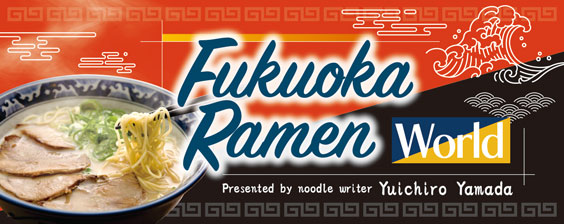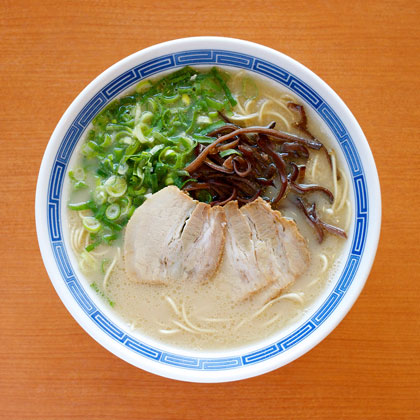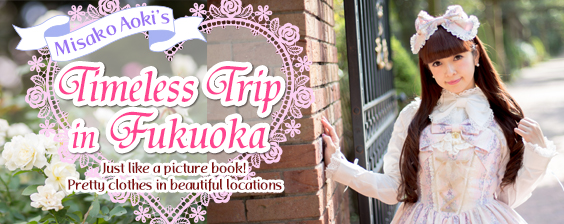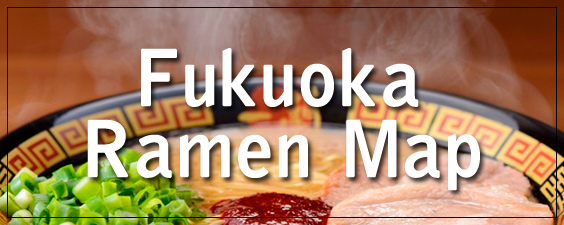- Home
- feature
- FUKUOKA RAMEN WORLD - Presente...
- What is Fukuoka Ramen?
What is Fukuoka Ramen?

The style of ramen differs according to the area!

You might think that tonkotsu (pork bone) is just one type of ramen but it actually comes in various forms with different areas having their own distinct preferences!
Kurume ramen has a number of unique characteristics. For example, the tonkotsu soup has a thick consistency and strong flavor. The noodles are straight and thicker than what you find with Hakata ramen. Chefs employ a traditional cooking method known as "yobimodoshi" (lit.: recall) to make the soup. They will not empty out the pot that is used to cook the broth. Instead, they will continue to add freshly prepared soup to help deepen the flavor. The "tare" (thick, sticky sauce) that is used to glaze "unagi" (eel) is created in a similar manner. It is a technique that helps ensure a strong flavor.
When it comes to Hakata ramen there are two sub-categories. "Nagahama ramen" is a dish that takes its name from an area in Fukuoka City. Nagahama is the location where the "kaedama" system of extra servings emerged. This gives diners the chance to order an extra serving of noodles that can be dropped into their bowls if they still have soup remaining. The other variation is known simply as "Hakata ramen." It is a dish that has been a favorite in the Hakata area for a long time. These days, people often refer to Nagahama and Hakata collectively as "Hakara ramen." In this dish, thin straight noodles are served in white cloudy tonkotsu soup.
In the south of Fukuoka Prefecture, there is an area called Omuta that has its own unique ramen culture. The noodles that are served in Omuta have developed independently from Hakata or Kurume. The roots of this ramen can be traced back to craftspeople from Okayama who moved to Omuta in the hope of starting a life. This occurred in the post World War Two period, while Omuta was thriving as a coal mining city. Subsequently, Okayama cuisine had a big impact on Omuta's ramen culture and noodle making techniques. That is why in Omuta you find not only white cloudy tonkotsu soups but also transparent versions. The latter is of significance as it not commonly attributed to tonkotsu ramen.
Make sure to familiarize yourself with the culture that surrounds Kitakyushu. There is no specific type of "Kitakyushu Ramen"... There are so many forms, it is hard to amalgamate them all under one heading. This is quite different to what you find in Kurume and Hakata! There is a famous eatery that has a strong connection to this topic. The founder of a Kurume-based ramen restaurant called "Sankyu" decided to hand over ownership of the premises and move to Kitakyushu. This individual went on to open the ramen joint "Rairaiken" in Kitakyushu City. The history of this establishment is one of the reasons why Kurume ramen has a strong influence on the area. Nonetheless, there is still a wide variety of tonkotsu ramen dishes available in Kitakyushu, including ramen with white foam on top and some that have a noticeably clear soup.
This article has highlighted that all kinds of tonkotsu ramen can be found in different areas. Flavors develop according to the characteristics associated with a given location. However, even within the same place you'll find all sorts of restaurants serving various types of ramen. It's not just the consistency of the broth... There are so many variables that can be altered!
Kurume ramen has a number of unique characteristics. For example, the tonkotsu soup has a thick consistency and strong flavor. The noodles are straight and thicker than what you find with Hakata ramen. Chefs employ a traditional cooking method known as "yobimodoshi" (lit.: recall) to make the soup. They will not empty out the pot that is used to cook the broth. Instead, they will continue to add freshly prepared soup to help deepen the flavor. The "tare" (thick, sticky sauce) that is used to glaze "unagi" (eel) is created in a similar manner. It is a technique that helps ensure a strong flavor.
When it comes to Hakata ramen there are two sub-categories. "Nagahama ramen" is a dish that takes its name from an area in Fukuoka City. Nagahama is the location where the "kaedama" system of extra servings emerged. This gives diners the chance to order an extra serving of noodles that can be dropped into their bowls if they still have soup remaining. The other variation is known simply as "Hakata ramen." It is a dish that has been a favorite in the Hakata area for a long time. These days, people often refer to Nagahama and Hakata collectively as "Hakara ramen." In this dish, thin straight noodles are served in white cloudy tonkotsu soup.
In the south of Fukuoka Prefecture, there is an area called Omuta that has its own unique ramen culture. The noodles that are served in Omuta have developed independently from Hakata or Kurume. The roots of this ramen can be traced back to craftspeople from Okayama who moved to Omuta in the hope of starting a life. This occurred in the post World War Two period, while Omuta was thriving as a coal mining city. Subsequently, Okayama cuisine had a big impact on Omuta's ramen culture and noodle making techniques. That is why in Omuta you find not only white cloudy tonkotsu soups but also transparent versions. The latter is of significance as it not commonly attributed to tonkotsu ramen.
Make sure to familiarize yourself with the culture that surrounds Kitakyushu. There is no specific type of "Kitakyushu Ramen"... There are so many forms, it is hard to amalgamate them all under one heading. This is quite different to what you find in Kurume and Hakata! There is a famous eatery that has a strong connection to this topic. The founder of a Kurume-based ramen restaurant called "Sankyu" decided to hand over ownership of the premises and move to Kitakyushu. This individual went on to open the ramen joint "Rairaiken" in Kitakyushu City. The history of this establishment is one of the reasons why Kurume ramen has a strong influence on the area. Nonetheless, there is still a wide variety of tonkotsu ramen dishes available in Kitakyushu, including ramen with white foam on top and some that have a noticeably clear soup.
This article has highlighted that all kinds of tonkotsu ramen can be found in different areas. Flavors develop according to the characteristics associated with a given location. However, even within the same place you'll find all sorts of restaurants serving various types of ramen. It's not just the consistency of the broth... There are so many variables that can be altered!
TEXT & PHOTO BY: Yuichiro Yamada
 Measures and provisions are being taken at various locations in an effort to prevent the spread of the new coronavirus.
Measures and provisions are being taken at various locations in an effort to prevent the spread of the new coronavirus.


















